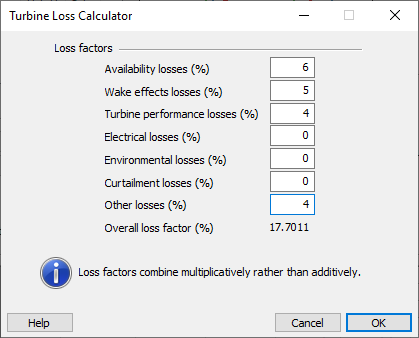
| Overall Loss Factor |  |
On the Wind Turbine Output window and the Wind Turbine Output Tool window you can enter seven loss factors that specify the amount of energy lost due to several factors:

| Loss Term | Description |
|---|---|
| Availability losses | The energy production lost when the turbine is offline due to component failure, scheduled maintenance, or repair (both within the turbine and in associated sytems, e.g. the external power grid). Because of the high availability of modern wind turbines and because operators can often schedule maintenance for low-wind times of the year, availability losses rarely exceed a few percent. |
| Wake effects losses | Losses resulting from aerodynamic interference between wind turbines in a wind farm. For a single wind turbine, the wake losses would be zero since no nearby wind turbines would interfere with the airflow. For a wind farm, the wake losses could range from a few percent (in the case of a very sparse arrangement or one designed to avoid such interference) to more than 10% (in the case of a dense or poorly-designed arrangement). |
| Turbine performance losses | Losses resulting from the turbine not performing as well as it is predicted to under ideal conditions. Examples include not producing to its reference power curve, losses due to turbulence, losses due to high shear conditions, etc. |
| Electrical losses | Losses within the electrical system. This includes all losses to the point of revenue metering, as well as parasitic consumption within the facility itself. |
| Environmental losses | Losses caused by a wide veariety of environmental factors. Includes losses caused by the accumulation of dirt or ice on the turbine blades, degradation of the blades over time, environmental events (e.g. lightning, hail, etc.) that require turbine shutdown, high and low temperature events, tree growth, etc. Such losses could range from near zero to several percent, depending principally on the frequency of icing events. |
| Curtailment losses | Losses resulting from the need to shutdown operation due to external factors (not including component failure or repair or environmental events). Examples include shutdown to reduce physical load on the turbine, limitations of the external power grid (e.g. limitations on the amount of power delivered), altered operations to reduce noise impact or impact on bird or bat migrations, etc. |
| Other losses | Any other factor that does not fit into the above categories. |
Windographer combines these four loss factors into the overall loss factor using the following equation:

where: | ||
| favail | is the availability losses factor | |
| fwake | is the wake effects losses factor | |
| fperf | is the turbine performance losses factor | |
| felec | is the electrical losses factor | |
| fenviro | is the environmental losses factor | |
| fcurtail | is the curtailment losses factor | |
| fother | is the other losses factor |
Windographer uses the overall loss factor to calculate a wind turbine's net power output, net energy output, and net capacity factor.
See also
Wind Turbine Output Tool window
Calculating the energy output of a wind turbine